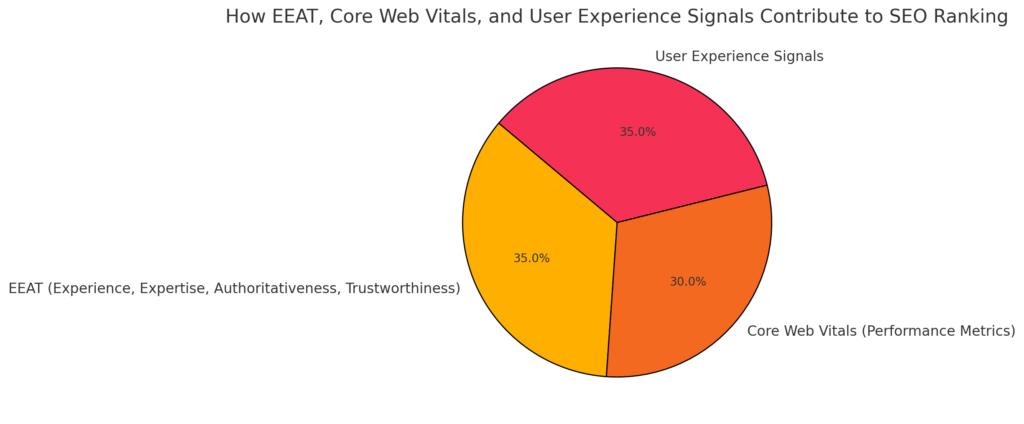Staying ahead in digital marketing means keeping up with the latest Google SEO updates. With every new change, marketers and webmasters must tweak their strategies to remain competitive. In this article, we’ll cover the most recent SEO updates, how they impact your ranking, and tips to adapt to these changes. Additionally, we’ll add some fun facts, pro tips, and visual elements to make this an engaging read.
What Are the Latest Google SEO Updates for 2024?
Google constantly updates its algorithm to ensure high-quality, relevant content for users. In 2024, the following updates are crucial for digital marketers and website owners:
1. Helpful Content System Update
The latest Helpful Content System focuses on promoting genuinely useful content for users. Google aims to rank articles that solve users’ queries directly rather than content overloaded with keywords. This change means that crafting informative, audience-centered content is now more important than ever.
Fun Fact: Did you know that 68% of online experiences begin with a search engine? That’s why having helpful content is vital for reaching your audience!
The Helpful Content System is all about providing value. To meet user expectations, it’s crucial to understand their intent and deliver high-quality answers. Google is also cracking down on content that exists solely to manipulate search rankings without offering genuine value to readers. As a result, your focus should be on crafting articles, blog posts, and resources that are meaningful and informative.
Pro Tip: Use tools like AnswerThePublic to understand what questions people are asking and create content that addresses these queries in detail.
2. Core Web Vitals Improvement
Google continues to emphasize Core Web Vitals as a significant ranking factor. Improvements in metrics like Largest Contentful Paint (LCP), First Input Delay (FID), and Cumulative Layout Shift (CLS) can significantly boost SEO performance. Ensure your website loads quickly, maintains stability, and is responsive to user actions.
| Core Web Vital | Description | Ideal Metric |
|---|---|---|
| Largest Contentful Paint (LCP) | Measures loading performance | Less than 2.5 seconds |
| First Input Delay (FID) | Measures interactivity | Less than 100 ms |
| Cumulative Layout Shift (CLS) | Measures visual stability | Less than 0.1 |
Pro Tip: Compress large images to improve LCP, and remove unnecessary JavaScript to enhance FID.
Optimizing these metrics is essential because they directly affect user experience. A fast and stable website encourages users to stay longer and explore more pages. Make use of lazy loading for images, and prioritize visible content to reduce LCP. Improving CLS by setting size attributes for media (images, videos) helps maintain visual stability during page load.
Fun Fact: According to Google, a one-second delay in page load time can lead to a 7% reduction in conversions.
3. Google EEAT (Experience, Expertise, Authoritativeness, Trustworthiness)
Google has expanded EAT to EEAT, adding Experience as an extra layer. Now, Google prefers content authored by people with firsthand experience. Highlighting the author’s expertise and including sources or credentials can improve your site’s trustworthiness and ranking.
Pro Tip: Make sure to include an About the Author section in your posts to improve credibility, and link it with authoritative sources like gov.in for extra weightage.
To boost your EEAT score, consider adding testimonials, case studies, and real-life examples to your content. This demonstrates that your content is based on actual experiences and adds depth to the information provided. The more credible your content appears, the more likely it is to rank higher in search results.
Fun Fact: Websites with an established author bio showing relevant experience see a 20% increase in user trust and engagement.
How to Adapt to These Changes?
- Focus on User Intent: The Helpful Content Update means you need to ensure your content is truly helpful and meets searcher intent. Answering questions and providing clear, direct information will help you rank better.
- Optimize Core Web Vitals: Test your website’s loading speed using Google PageSpeed Insights. Compress images, minimize JavaScript, and consider adopting a Content Delivery Network (CDN) to improve page load time.
- EEAT Strategy: Ensure all content is written or reviewed by experts in the field. Highlight your agency’s achievements and link to authoritative websites to add more credibility to your articles. Example: Nova Vision Media Tech offers reliable SEO solutions based on proven expertise.
- Content Updates and Consistency: Google values fresh content. Regularly updating your content ensures it stays relevant, informative, and helpful to users. Revisit your high-ranking articles and add recent stats, new examples, or updated insights to keep them fresh.
Fun Fact: Pages that load in under 2 seconds have an average bounce rate of 9%, while pages that take 5 seconds to load have a bounce rate of 38%!
Pro Tip: Creating a content calendar helps you stay consistent with updates, ensuring your website always offers value.
- Leverage Structured Data: Adding structured data to your website helps Google better understand your content, which can lead to rich snippets in search results. Rich snippets increase your click-through rate and visibility on search engines.
Fun Fact: Websites using structured data have a 20-30% higher chance of getting rich snippets compared to those that don’t.
Pro Tip: Use tools like Google’s Structured Data Markup Helper to add and validate schema markup on your pages.
How Google SEO Ranking Signals Work Together

A diagram showcasing how EEAT, Core Web Vitals, and user experience signals contribute to SEO ranking.
Each of these ranking signals works in tandem to determine how Google perceives your website. While individual optimizations are important, understanding how they fit together to create a positive user experience is key.
Pro Tip: Keep a balance between technical SEO and content quality. A well-optimized website with unhelpful content will struggle to rank.
Fun Fact: Nearly 40% of internet users will leave a website if it takes more than three seconds to load, highlighting the importance of Core Web Vitals.
Top Questions About Google’s SEO Updates
Q1: How often does Google update its SEO algorithm?
Google makes minor updates almost daily, but major updates (like Helpful Content or Core Updates) are rolled out 3-4 times a year.
Google’s minor updates help tweak results and improve search quality. However, the major core updates are the ones that cause significant ranking shifts. Staying informed of these updates is crucial to avoid sudden drops in visibility.
Q2: How can I check if my website is affected by an update?
You can use tools like Google Search Console or SEMrush to analyze changes in website traffic. Sharp drops or gains might indicate you were affected by an update.
Check for any significant fluctuations in organic traffic after a major update is announced. Use comparison tools to see if the drop is specific to certain pages or keywords. Identifying these can help in making necessary adjustments to recover.
Q3: What should I do if my rankings dropped after an update?
First, identify the root cause. It might be poor-quality content or slow load speed. You can use tools like Ahrefs or Moz to identify problem areas and fix them.
Start by auditing your content for quality and relevance. If a page that ranked well suddenly drops, assess its content compared to top-ranking competitors. Look at aspects like comprehensiveness, user engagement, and technical performance.
Pro Tip: Regularly update your old content to make sure it stays relevant and meets current Google standards.
Q4: How do Core Web Vitals affect user experience?
Core Web Vitals are directly linked to user experience metrics. Faster load times, smoother interactions, and visual stability all contribute to how enjoyable a visitor’s experience is on your site. Improving Core Web Vitals can reduce bounce rates and increase time on site.
Fun Fact: Users are 24% less likely to abandon a site if it meets all Core Web Vitals thresholds, showing how crucial these metrics are for engagement.
Future SEO Predictions
- AI Content: Google is becoming better at distinguishing between automated and human-generated content. Make sure you add unique value that AI tools can’t replicate.
As AI-generated content becomes more prevalent, Google emphasizes authenticity and originality. To stay competitive, focus on adding a human perspective to your content. AI can assist with writing, but the insights, experiences, and creativity that come from real individuals make a significant difference.
Fun Fact: By 2025, it is estimated that AI will contribute to 30% of the total content found on the web. However, human touch and originality will always be preferred by Google!
- Voice Search Optimization: With increased adoption of voice assistants, optimizing for voice queries (which are longer and conversational) will be a critical aspect of SEO strategy.
Voice search is evolving, and optimizing for conversational language is key. Focus on long-tail keywords and question-based content to meet voice search requirements. Structuring your content in an FAQ format can help you capture these types of queries more effectively.
Pro Tip: Use tools like AnswerThePublic to find out what questions people ask and integrate these naturally into your content.
- Visual and Video Content: Visual content is becoming increasingly important. YouTube is the second largest search engine, and optimizing your video content is a growing aspect of SEO.
Fun Fact: Videos are 50 times more likely to get organic page ranks in Google compared to plain text results.
- Local SEO and Hyper-Localization: As Google continues to evolve its understanding of user intent, local SEO will become more critical. Hyper-local content that answers very specific geographic queries will help businesses stand out.
Pro Tip: Optimize your Google My Business profile and encourage reviews to boost your local SEO visibility.
- Nova Vision Media Tech for digital marketing services.
- Connect with News Pop Hub for the latest digital marketing news and updates.
Pro Tip: Internal linking can improve user navigation and help search engines understand the structure of your website. Always link related articles within your site to increase time on page.
Fun Fact: Content with at least 5 outbound links to high-authority domains ranks better because it helps Google understand that the content is well-researched.
Fun Facts About Google SEO
- Fun Fact #1: Google’s search index is over 100 million gigabytes in size, making it one of the largest databases in the world.
- Fun Fact #2: Google’s algorithm uses over 200 ranking factors to determine where a page should rank in the SERPs.
- Fun Fact #3: The average click-through rate for websites listed on the first page of Google is 71%, which drops significantly for second-page results.
- Fun Fact #4: Nearly 50% of users start their search with four words or longer phrases, emphasizing the importance of long-tail keywords in SEO.
- Fun Fact #5: Mobile-first indexing means Google predominantly uses the mobile version of the content for indexing and ranking.
- Fun Fact #6: Websites that feature high-quality images are 94% more likely to attract user attention, highlighting the importance of visual elements in SEO.
Conclusion
Google’s SEO updates for 2024 are aimed at providing a better user experience. By focusing on creating helpful content, optimizing site performance, and showcasing real expertise, you can stay ahead in the search rankings game.
If you need help navigating these changes, visit Nova Vision Media Tech for professional SEO services. For more SEO news and updates, keep an eye on News Pop Hub.
Remember, SEO is an ongoing process. By staying informed, keeping your content fresh, and providing genuine value to your audience, you can maintain a competitive edge in 2024 and beyond.
Pro Tip: Don’t just focus on rankings—build a strong user base by providing value. User experience, engagement, and satisfaction are crucial for long-term success.
Fun Fact: Companies that blog regularly see 97% more links to their website, which can significantly impact SEO performance.



